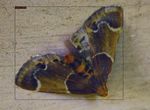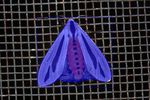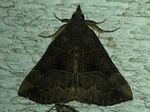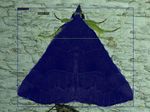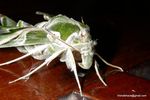Zero-Shot Insect Detection via Weak Language Supervision
←
→
Page content transcription
If your browser does not render page correctly, please read the page content below
Zero-Shot Insect Detection via Weak Language Supervision
Benjamin Feuer,1 Ameya Joshi,1 Minsu Cho,1 Kewal Jani,1 Shivani Chiranjeevi, 2 Zi Kang Deng, 3
Aditya Balu, 2 Asheesh K. Singh, 2 Soumik Sarkar, 2 Nirav Merchant, 3 Arti Singh, 2
Baskar Ganapathysubramanian, 2 Chinmay Hegde 1
1
New York University
2
Iowa State University
3
University of Arizona
Abstract
Open source image datasets collected via citizen science plat-
forms (such as iNaturalist) can pave the way for the de-
velopment of powerful AI models for insect detection and
classification. However, traditional supervised learning meth-
ods require labeled data, and manual annotation of these raw
datasets with useful labels (such as bounding boxes) can be Aedes Vexans Hypena Deceptalis Pyralis Farinalis
extremely laborious, expensive, and error-prone. In this pa-
per, we show that recent advances in vision-language models
enable highly accurate zero-shot detection of insects in a va-
riety of challenging environs. Our contributions are twofold:
a) We curate the Insecta rank class of iNaturalist to form a
new benchmark dataset of approximately 6M images con-
sisting of 2526 agriculturally important species (both pests
and beneficial insects). b) Using a vision-language object de- Green Grasshopper Green Stinkbug Brown Stinkbug
tection method coupled with weak language supervision, we
are able to automatically annotate images in this dataset with Figure 1: Example bounding boxes and segmentation maps
bounding box information localizing the insect within each with zero-shot DETIC.
image. Our method succeeds in detection of diverse insect
species present in a wide variety of backgrounds, producing
high-quality bounding boxes in a zero-shot manner with no
additional training cost. the background (for example, green colored insect-pests on
green backgrounds).
Introduction The availability of massive open source image datasets
(such as iNaturalist (Van Horn et al. 2018)) acquired in a
Insect pests in the agricultural sector cause infestation and crowd-sourced manner can be leveraged to build powerful
damages to crops resulting in significant economic losses. deep neural network models that perform accurate insect
Improper identification of species (as well as their num- classification and detection. However traditional deep neu-
ber density, called the action threshold) could potentially ral network-based object detectors require high quality an-
result in unnecessary application of chemicals that could notations (or labels) for all image sample in these datasets.
harm beneficial insects, reduce profitability, and have an ad- Annotating labels for object detection involves either pixel-
verse environmental footprint. While manual scouting re- by-pixel labelling of class information, or marking of tight
mains the gold standard for pest identification and action bounding boxes for every image in a dataset. Consequently,
threshold determination, this is a resource and (expert)labor creating datasets for AI models for insect detection in a su-
intensive, yet critical aspect of agriculture. There is signifi- pervised manner can be very laborious, time consuming, and
cant opportunity for computer vision and AI/ML approaches prone to errors.
to contribute to automating this process. However, the task
of identification and localization of insects is very challeng- To overcome this, we leverage recent advances in vision-
ing due to (a) the large number of species, (b) several distinct language modeling. Starting from CLIP (Radford et al.
species that exhibit remarkably similar visual features, (c) 2021), the key idea has been to pre-train deep networks that
species exhibiting very diverse features along their develop- learn to match image data (possibly gathered in an unstruc-
mental cycle (nymph vs adult, larva vs pupa vs adult), and tured manner) to associated captions that describe the con-
(d) images where the insect is difficult to differentiate from tents of the images using natural language descriptions. The
resulting models are remarkably robust: CLIP-style models
Copyright © 2023, Association for the Advancement of Artificial produce representations of images that transfer very well to
Intelligence (www.aaai.org). All rights reserved. a variety of downstream tasks. For many applications thesemodels also enable zero-shot performance, i.e., no extra su- second half, fc : Rm → R4 × [c] takes in every proposal
pervision involving additional training data or computation with an objectness score higher than a threshold and outputs
is required. Rather, inference can be performed by simply a bounding box with the corresponding prediction. The net-
specifying the category/class using a new natural language works are trained only on Ddet .
description. In our application, we show that merely cou- Detic improves upon this by training fc on both Ddet
pling a recently proposed vision-language object detector and Dcls . The classification head in fc is also replaced with
(Zhou et al. 2022) with a single (universal) natural language CLIP (Radford et al. 2021) embeddings as weights to add
prompt provides highly accurate bounding box for a very open-set classification capabilities. Every minibatch consists
large dataset of diverse insect-pest images. of mix of samples from Ddet and Dcls . The training ex-
In summary, our contributions in this paper are twofold: amples from Ddet are trained using the standard detection
1. We curate the Insecta rank class of iNaturalist to form loss (boxwise regression and classification losses). Exam-
a new benchmark dataset of approximately 6M images ples from Dcls are assumed to have a single detected object
consisting of 2526 agriculturally important species. We (the largest detected box) with the image label as the box
perform manual quality checking of a subset of these im- label. The model is then trained with the following loss:
ages.
LRP N + LReg + Lcls , if I ∈ Ddet
2. Using a vision-language object detection method coupled L(I) =
λLmax−size , if I ∈ Dcls
with weak language supervision, we are able to automat-
ically annotate images in this dataset with bounding box Note that here, LRP N , Lreg , and Lcls refer to the training
information localizing insect-pests in each image. losses from (Ren et al. 2015) while Lmax−size is a cross-
Our method succeeds in detection of diverse insect-pests entropy loss with the target as the image class. DETIC has
present in a wide variety of backgrounds. In the absence two advantages over traditional detectors; (1) it can learn
of ground truth, we performed manual quality checks; over from image classification datasets which are generally larger
a carefully selected subset of images with diverse insect- than detection datasets, and contain a variety of classes, and,
pest categories, our method exhibited tight bound bounding (2) the CLIP embeddings used as the classification head al-
boxes in large fraction of the samples; therefore, we expect low for a far larger number of classes. Thus, contrary to stan-
that our new benchmark dataset can be used in the future for dard detection models, DETIC does not require fine-tuning,
building high-quality supervised models as well. and can be used for zero-shot detection with natural images.
Background: Zero-Shot Detection A New Benchmark Dataset
Detection models focus on two loosely correlated problems: iNaturalist is a citizen science platform where users can
localizing objects of interest in an image, and assigning upload photographs of specific organisms. The iNaturalist
labels to them. One popular approach is a two-stage pro- Open Data project is a curated subset of the overall iNatu-
cess (Ren et al. 2015; Girshick 2015; He et al. 2020; Lin ralist dataset that specifically contains images that apply to
et al. 2020) wherein the models detect probable object re- the Creative Commons license created by iNaturalist specif-
gion proposals, and further finetune the bounding boxes and ically to aid academic research.
predict classes. In contrast, a single shot detector (Redmon We created a workflow tool, iNaturalist Open Download,
and Farhadi 2018, 2017) not only generates region propos- to easily download species images from the iNaturalist Open
als but also classifies them in a single forward pass. Both of Dataset associated with a specific taxonomy rank. We used
these however rely on high quality, fine grained annotations the tool to download all images of species under the rank
of localized objects in an image for training. Recent work on class Insecta from the iNaturalist Open Dataset for down-
weak supervision for detection (Fang et al. 2021; Xu et al. stream annotation, curation and use in our model. We choose
2021) attempt to resolve the need for such fine-grained la- to only use images identified as “research” quality grade un-
belling by assigning labels to boxes based on model predic- der the iNaturalist framework, which indicates that the la-
tions. For example, YOLO9000 (Redmon and Farhadi 2017) beling inspection for the image is more rigorous than stan-
assigns labels to boxes based on the magnitude of prediction dard and has multiple agreeing identifications at the species
scores from the classification head. This however requires level. This results in a total of 13,271,072 images across
good quality box proposals apriori which may be hard to 95,399 different insect species at the time of writing. The im-
achieve essentially leading to a circular problem of needing ages have a maximum resolution of 1024x1024, in .jpg/.jpeg
good boxes for good class predictions and vice-versa. format and total 5.7 terabytes. Among the 95,399 insect
Detic (Zhou et al. 2022) presents an interesting zero-shot species, we select 2526 species which have been reported
solution to this problem by training detection models si- to be the most agriculturally important species. This subset
multaneously with object detection and image classification of insect classes contribute to 6 million images in total.
datasets. Formally, let Ddet = {xi , {bi,j , ci,j }} consist of
images with labelled boxes, and Dcls = {xi , ci } be a clas- Experimental Results
sification dataset with image-level labels. Traditional detec- We use the highest performing DETIC model from (Zhou
tion networks consist of a two-stage detector; the first half et al. 2022) with the SWINB backbone. The model has been
of the network, fD : Rd → {Rm × [0, 1]} outputs a set of trained on the COCO and Imagenet-21k datasets, with Cen-
bounding boxes and corresponding objectness scores. The ternet employed as the region proposal network. We run theCabbage Looper Grasshopper Lacewings Leaf Hopper Stinkbug
Figure 2: Detic results for green-colored insect-pests.
Species Accuracy Species Accuracy
22-Spotted LadyBird 87.5 Cabbage Looper 88.9
Brown Marmorated Stink Bug 88.9 Green Lacewing 66.7
Cabbage White 55.6 Green Grasshopper 62.5
Corn Earworm 100.0 Green Leaf Hopper 100.0
Cotton Bollworm 100.0 Green Stink Bug 100.0
Fall Armyworm 88.9 Average 83.6
Golden Rod Soldier Beetle 83.4
Japanese Beetle 88.9 Table 2: Accuracy of detecting insects on challenging back-
Red Milkweed Beetle 100.0 grounds, specifically green insect-on-green background.
Silver-spotted Skipper 100.0
Tobacco Hornworm 70.0
Average 87.6 insect in the image has been localized with a tight bounding
box as well as a high-quality pixel-wise semantic segmenta-
Table 1: Accuracy of detecting a diverse set of insect species. tion map.
Table 1 shows the results of our manual quality check over
a list of nearly 150 image samples taken from a diverse set of
detector on images in our curated benchmark dataset. Our insect species. This diverse dataset spans species across the
vocabulary only contains the lone word ”insect”, and there- phylogenic tree of the insecta order (for instance, winged
fore is an example of (very) weak language supervision. In vs wingless, ect). Domain experts were asked to label an
order to ensure high recall, we use low objectness confidence output as “correct” if a tight bounding box was achieved,
thresholds of 0.1 and 0.3. and quality labels were tabulated. We see that performance
Our results show the considerable promise of zero-shot is high, with a quality metric of nearly 88%. Figure 3 shows
localization on this dataset. Figure 1 (and Figure 5 in ap- example images from this test set.
pendix) show example results; in all cases, we see that the We also find that our method succeeds in challengingCabbage White Corn Earworm Ladybird Japanese Beetle Tobacco Hornworm
Figure 3: Detic results on a diverse set of insect species.
prompts. Finally, we expect the curated, quality controlled
dataset to be of significant interest to the CV community.
References
Fang, S.; Cao, Y.; Wang, X.; Chen, K.; Lin, D.; and
Zhang, W. 2021. Wssod: A new pipeline for weakly-
and semi-supervised object detection. arXiv preprint,
arXiv:2105.11293.
Girshick, R. B. 2015. Fast R-CNN. ICCV, 1440–1448.
He, K.; Gkioxari, G.; Dollár, P.; and Girshick, R. B. 2020.
Figure 4: Detection of multiple insects in the same image. Mask R-CNN. T-PAMI, 42: 386–397.
Lin, T.-Y.; Goyal, P.; Girshick, R. B.; He, K.; and Dollár, P.
2020. Focal Loss for Dense Object Detection. T-PAMI, 42:
scenarios, such as green-species captured on a green back- 318–327.
ground, which is a fairly common occurrence. Figure 2
Radford, A.; Kim, J. W.; Hallacy, C.; Ramesh, A.; Goh, G.;
shows example results from a subset of such images. Here
Agarwal, S.; Sastry, G.; Askell, A.; Mishkin, P.; Clark, J.;
also, our method succeeds with high accuracy (over 83%);
et al. 2021. Learning transferable visual models from nat-
the green grasshopper (with its natural camouflaging prop-
ural language supervision. In International Conference on
erty) was the most challenging to detect, as expected. See
Machine Learning, 8748–8763. PMLR.
Table 2 for details.
Finally, we find that our method performs well even when Redmon, J.; and Farhadi, A. 2017. YOLO9000: Better,
there are multiple insects (of the same species) in the same Faster, Stronger. In CVPR, 6517–6525.
image. See Figure. 4 that illustrates correct detection and Redmon, J.; and Farhadi, A. 2018. YOLOv3: An Incremen-
bounding box construction on a major pest (fallarmy worm). tal Improvement. ArXiv, abs/1804.02767.
Creating correct bounding boxes on multiple insects in the Ren, S.; He, K.; Girshick, R. B.; and Sun, J. 2015. Faster
same image is critical to accurately evaluating the action R-CNN: Towards Real-Time Object Detection with Region
threshold in integrated pest management. Proposal Networks. T-PAMI, 39: 1137–1149.
Van Horn, G.; Mac Aodha, O.; Song, Y.; Cui, Y.; Sun, C.;
Conclusions Shepard, A.; Adam, H.; Perona, P.; and Belongie, S. 2018.
We show that new advances in vision-language models can The inaturalist species classification and detection dataset.
be used to effectively localize insects in unstructured im- In Proceedings of the IEEE conference on computer vision
age data (in a fully zero-shot manner, without requiring any and pattern recognition, 8769–8778.
training). Xu, M.; Zhang, Z.; Hu, H.; Wang, J.; Wang, L.; Wei, F.; Bai,
Our preliminary findings pave the way for further im- X.; and Liu, Z. 2021. End-to-end semi-supervised object
provements in this area. First, our generated bounding box detection with soft teacher. In ICCV.
information can be useful in other downstream tasks in in-
Zhou, X.; Girdhar, R.; Joulin, A.; Krähenbühl, P.; and Misra,
sect/pest monitoring, such as visual odometry and decision
I. 2022. Detecting twenty-thousand classes using image-
support. Second, better bounding boxes can be achieved per-
level supervision. arXiv preprint arXiv:2201.02605.
haps with improved language supervision and class-specificAedes Vexans Creatonotos Gangis Daphnis Neril Hypena Deceptalis Pyralis Farinalis
Figure 5: Zero-shot bounding box generation and segmentation map obtained using DETIC.You can also read





